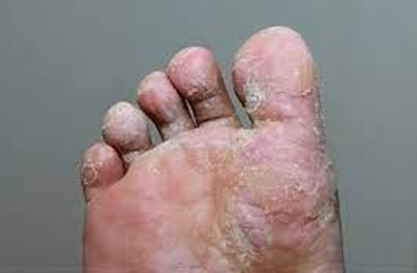A nurse in a provider's office is caring for a client who has a new diagnosis of tinea pedis, which of the following findings should the nurse expect?
Circular, erythematous patches on the scalp
Scaling and redness between the client's toes
Report of recent exposure to poison ivy
Report of a recent prescription for an antiseizure medication
The Correct Answer is B
Choice A rationale: Circular, erythematous patches on the scalp are more indicative of tinea capitis, a fungal infection affecting the scalp, and not tinea pedis.
Choice B rationale: Tinea pedis, commonly known as athlete's foot, typically presents with symptoms such as scaling, redness, and itching between the toes. It is a fungal infection affecting the feet.
Choice C rationale: Poison ivy exposure would result in contact dermatitis, characterized by a rash and blistering, rather than the typical presentation of tinea pedis.
Choice D rationale: Antiseizure medications are not typically associated with the development of tinea pedis; the symptoms described are more consistent with a fungal infection.

Nursing Test Bank
Naxlex Comprehensive Predictor Exams
Related Questions
Correct Answer is ["A","B","D","E"]
Explanation
Choice A rationale: Hyperlipidemia, particularly elevated cholesterol levels, can be associated with impaired wound healing. High cholesterol levels can contribute to atherosclerosis, leading to reduced blood flow to the wound site. Adequate blood supply is crucial for delivering oxygen and nutrients essential for the healing process.
Choice B rationale: Diabetes mellitus is a well-known risk factor for delayed wound healing. High blood sugar levels can impair the function of white blood cells, reduce collagen formation, and impair the overall healing process. Furthermore, individuals with diabetes are more prone to infections and may experience slower wound closure.
Choice C rationale: Medication history alone does not provide specific information about factors that directly affect wound healing. However, certain medications, such as corticosteroids or immunosuppressive drugs, may impact the healing process.
Choice D rationale: High cholesterol levels can contribute to atherosclerosis, leading to reduced blood flow to the wound site. Adequate blood supply is crucial for delivering oxygen and nutrients essential for the healing process.
Choice E rationale: Prealbumin is a marker of protein status and nutritional adequacy. Low prealbumin levels can indicate malnutrition, which is a risk factor for delayed wound healing. Adequate protein intake is crucial for collagen synthesis and overall tissue repair.
Correct Answer is C
Explanation
- A: Swabbing the wound bed is an essential step in obtaining a wound culture, but it is not the first action that should be taken. This step is performed after the wound has been cleansed to ensure that the sample is not contaminated with debris or bacteria from the surrounding skin.
- B: Cleansing the area around the wound with sterile saline is the correct first step. This action helps to remove any contaminants or debris from the wound surface, ensuring that the culture obtained is from the wound itself and not from the surrounding skin, which could lead to inaccurate results.
- C: Donning sterile gloves is a crucial step to maintain sterility during the procedure. However, it is not the first action because the nurse must first cleanse the wound area to prevent contamination of the culture specimen.
- D: Placing the collection tube in a specimen bag is done after obtaining the wound culture to transport the specimen to the laboratory. This is one of the final steps in the process, not the first.
Whether you are a student looking to ace your exams or a practicing nurse seeking to enhance your expertise , our nursing education contents will empower you with the confidence and competence to make a difference in the lives of patients and become a respected leader in the healthcare field.
Visit Naxlex, invest in your future and unlock endless possibilities with our unparalleled nursing education contents today
Report Wrong Answer on the Current Question
Do you disagree with the answer? If yes, what is your expected answer? Explain.
Kindly be descriptive with the issue you are facing.
